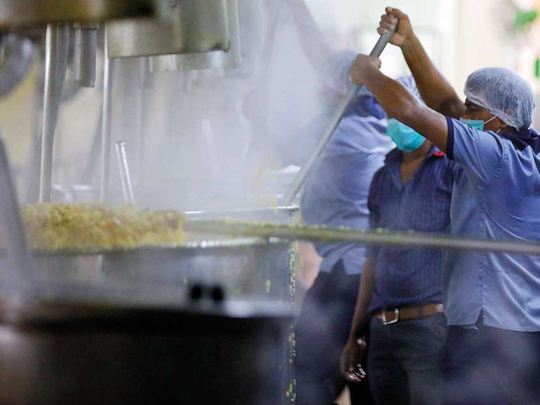
Google “world’s largest kitchen” and it throws up only one name — the Golden Temple in the Indian city of Amritsar where up to 100,000 people are served free meals every day.
The food is prepared and served to devotees by an army of volunteers throughout the day.
Now, imagine a kitchen where up to 100,000 meals are prepared six days a week and delivered to more than 1,300 schools located in remote locations. The meals must reach before lunch break and served hot at 60 degrees.
Tucked away in one corner of the sprawling industrial complex of Amausi in Lucknow, Akshaya Patra is one of a kind kitchen in northern India. This massive facility, built on a two-acre plot, is a successful collaboration between a nonprofit entity and state to provide free hot meals to students in government-funded schools.
Step inside and you feel as if you are entering a giant Moroccan bath where hot steam begins to open your pores and strong smell of spices, boiling milk and rice overwhelm your senses. Through dense clouds of steam, you see masked workers hunched over a row of huge steel cauldrons filled with rice and vegetables. A level above, milk and rice are boiling in giant containers and workers stir them occasionally to check consistency of the pudding. The roti machines — capable of doling out 45,000 pieces an hour — are sitting idle as today’s menu has two dishes, vegetable pulao and pudding.
On the first floor earlier, a team of workers washed, peeled and diced potato, cabbage, carrots, mixed them with rice and soya chunks before despatching them to the cauldrons below through sterilised chutes. It’s 3am and workers are racing to meet the deadline, 60,000 meals must leave the facility by 7.30am.
“We track each and every cauldron methodically. Temperature, cooking time are recorded at every stage of the process so that we know which school got food from which cauldron,” Sunil Mehta, operations manager, told Weekend Review.
The facility follows a strict protocol of purchasing, storing, handling, processing raw material and the 200 workers of the facility wear masks, hair caps, and shoe covers. Raw material and food is not touched by human hands at all, says Mehta.
The scale of the operation can be gauged by the quantity of raw material used in preparing meals. The facility requires 6,500 kilograms of rice every day, consumes 1,400 kg of spices and 3,000 kg of salt every month.
After the food is cooked, meals are packed in airtight steel containers labelled with school name, address and quantity. Food must be packed at 80 degrees and served at 60 degrees Celsius. In one corner, a conveyor belt pushes the steel containers out of the kitchen to the loading bay. Outside, 54 vehicles are loaded and each driver is given a thermometer to record the temperature after reaching the destination. Besides timely delivery of food, the drivers have another important task, they get the day’s attendance of schools and estimates for the following day. “That helps us in preparing the meal order for the following day,” says Mehta.
The kitchen has a set menu and includes chickpeas, kidney beans, spinach, potatoes, pulses, bread and rice. As this kitchen caters to students in north India, a wheat-based diet is served. On Monday, roti and mixed vegetables with soya chunks is served. Soya chunks are rich sources in vitamin B, omega-3 fatty acids, protein, calcium and iron, which is an excellent replacement for all meat-based proteins.
“We have noticed an improvement in attendance on Wednesday when we serve milk-rice pudding,” says Mehta.
During production, personal hygiene of workers comes first, those having infectious diseases are not allowed in the kitchen and chewing tobacco or eating inside the kitchen, touching raw ingredients and cooked food with bare hands are prohibited.












